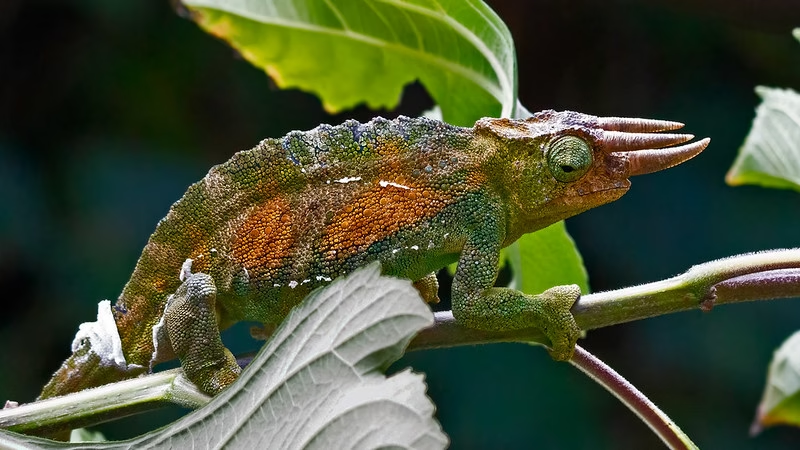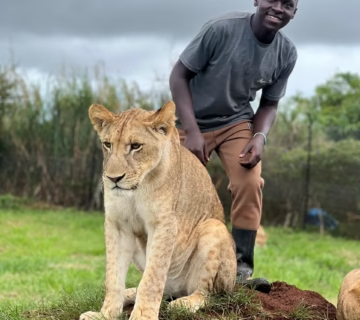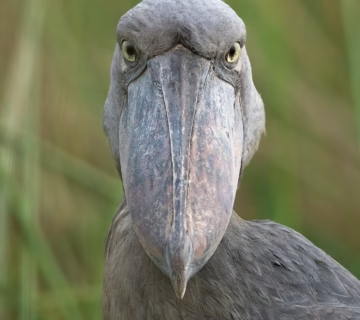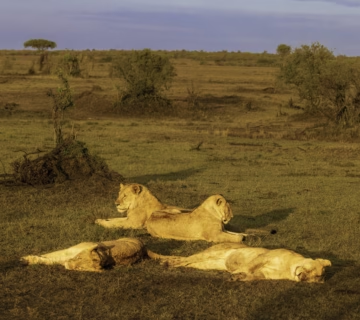The Three horned chameleons in Bwindi impenetrable national park.
The unique species of three-horned chameleons may be found in the misty woods of Bwindi Impenetrable National Park, which is situated in the Kanungu area in the southwest of Uganda. In addition, the national park is well-known for its mountain gorillas, over 350 bird species, including 23 unique species of the Albertine Rift, animals such forest elephants, buffaloes, and duikers, and other primate species like l’hoest monkeys and black and white colobus monkeys.
Mature male chameleons have three brown horns on their foreheads: one on the snout, and the other two above the superior orbital ridge, which comes after the eyes. These chameleons are also called Trioceros Jackson.
The three-horned chameleons, like other chameleons, use color changes to blend in with their surroundings, communicate, and conceal themselves from predators like birds and poisonous snakes.
Information about the Jackson or three-horned chameleons in Bwindi Impenetrable National Park
One of the unique species of East Africa, the three-horned chameleon is mostly found in regions that are at least 1,700 meters above sea level.
Only the Bwindi Impenetrable National Park, Rwenzori National Park, Mgahinga Gorilla National Park, and other locations in Rwanda and the eastern Democratic Republic of the Congo are home to the three-horned chameleons, which are indigenous to the Albertine Rift Valley region.
The ability of the three-horned chameleons’ eyes to spin 360 degrees allows them to see in all directions without moving, which aids in both catching prey and defending against predators.
The three-horned chameleons can catch insects such as grasshoppers, crickets, spiders, butterflies, and beetles thanks to the special muscles at the tip of their tongues.
An adult three-horned chameleon may live for more than five years and reach a length of thirty cm.
The ideal time to explore the impenetrable national park of Bwindi
Although Bwindi Impenetrable National Park is open year-round, the ideal time to come is during the dry season, which is also referred to as the peak season, which runs from June to September and December to February.
In contrast to the wet/rainy season, when the routes are wet, muddy, and slippery, making chameleon tracking difficult, the dry season brings access roads and gorilla trekking trails that are dry and navigable since the national park gets little to no rainfall.
How to go to the impenetrable national park of Bwindi
The southwest region of Uganda is home to Bwindi Impenetrable National Park, which is reachable by road transportation. From Kampala or Entebbe, you will go via Masaka, Mbarara, Kabale, and finally to the park headquarters, which takes around eight to nine hours in a four-wheel drive safari vehicle.
Travelers may also reach Bwindi Impenetrable National Park from Kigali, Rwanda, by flying into Kigali International Airport and then continuing on a three to four-hour drive across the Cyanika border in Kisoro or the Katuna border in Kabale.
Bwindi Impenetrable National Park may also be reached by air. To achieve this, you can arrange for scheduled or charter flights with Aerolink Uganda from Entebbe International Airport or Kajjansi Airfield to Kihihi or Kisoro Airstrip. From there, you can take a road drive to the park headquarters.
Accommodations in the impenetrable national park of Bwindi
During your safari, you may stay at any of the many lodging options in Bwindi Impenetrable National Park. Four Gorillas Lodge, Nkuringo Bwindi Gorilla Lodge, Volcanoes Bwindi Gorilla Lodge, Buhoma Lodge, Ichumbi Gorilla Lodge, Wag Tail Safari Lodge, Ruhija Gorilla Mist Camp, Ruhija Gorilla Safari Lodge, Gift of Nature lodge, Cuckooland Tented lodge, Ruhija Gorilla Safari Lodge, Chameleon Hill lodge, Bwindi Jungle View lodge, Bwindi Guest House, Buhoma Community Rest Camp, Clouds Mountain Gorilla Lodge, Gorilla Resort, Engagi lodge, Eco Marvels Gorilla Lodge, Mahogany Springs Lodge, Lake Kitandara Bwindi Camp, Nshongi Camp, Silverback lodge, Sanctuary Gorilla Forest Camp, and Ruhija Gorilla Friends Resort are just a few of the lodging options that range from affordable to luxurious.



